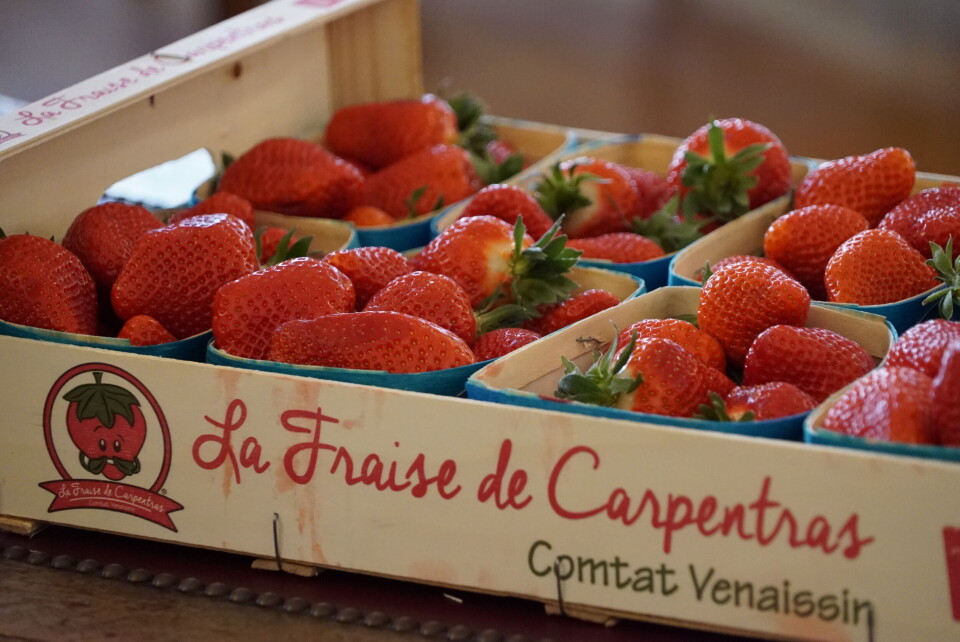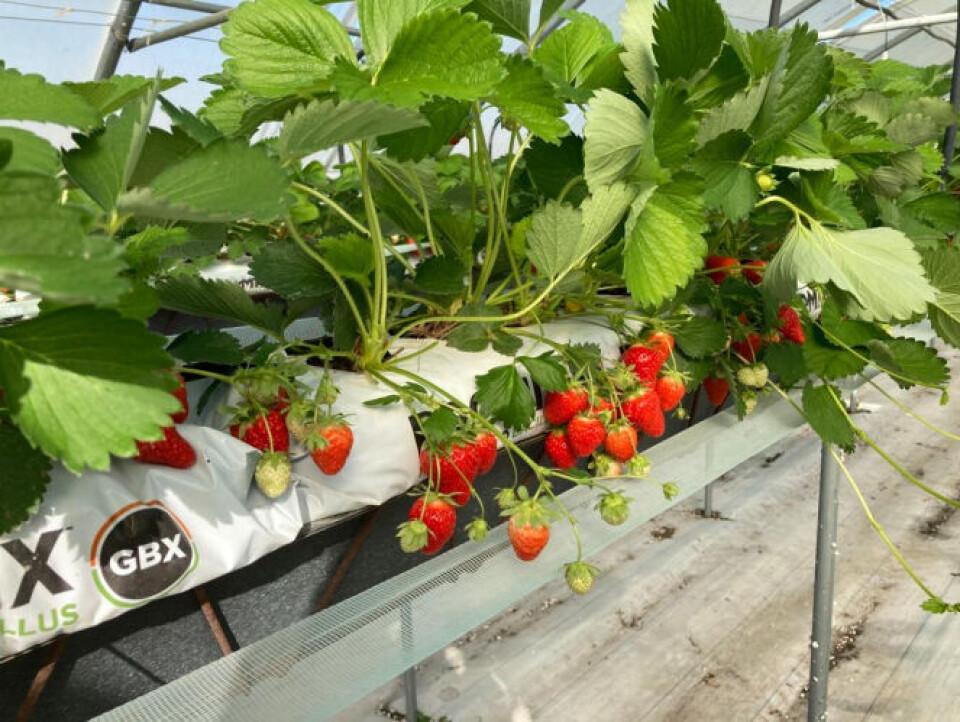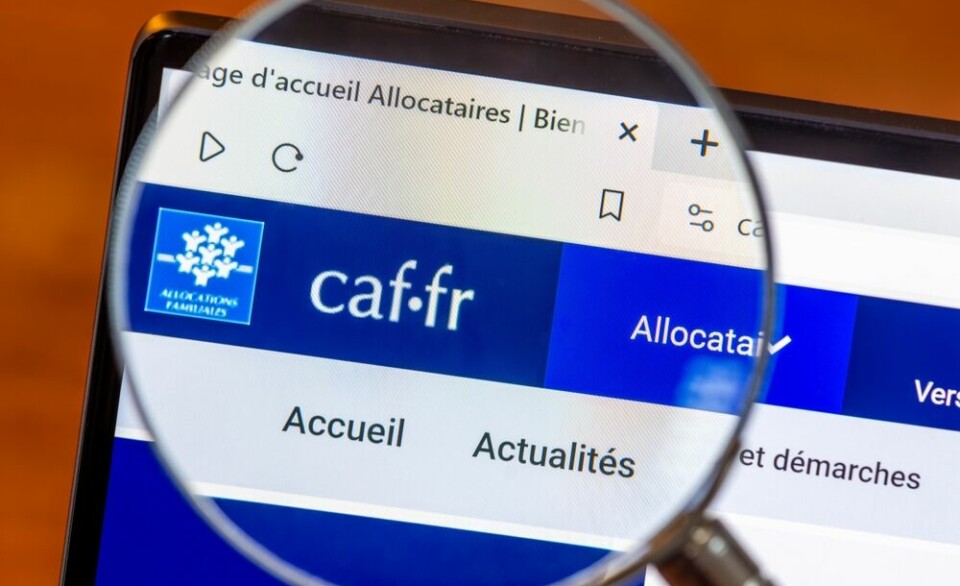-
Which is the cheapest supermarket in France?
A new study shows just how close prices for common food items can be across brands
-
Did you know? France invented the strawberry
As strawberry season gets underway, you might be surprised to hear that garden strawberries originated in France and can be used in many ways
-
Sweet and flavoursome: France’s strawberry season starts now
The first gariguettes are already being picked in south-west France. Supermarket prices are around €3.99 a 250g punnet
France’s Carpentras strawberry crops bring juicy joy
One of the first French strawberries of the year, the ‘fraise de Carpentras’ is grown on the sunny Vaucluse plains

The term ‘Carpentras strawberry’ is very old – “dating back to the 1900s, when strawberries from the villages of Monteux, Loriol, Sarrians or Pernes were sent by train from Carpentras to Paris”, says Philippe Bon, a fifth-generation strawberry grower in Monteux, in the Vaucluse department.
“It was also at this time,” he adds, “that my great-grandfather, came down from the mountains and started growing strawberries because he could now irrigate the plantations thanks to the Carpentras canal, built under Napoleon III. Without this canal, there would never have been all these strawberries here.”
More than a century later, the Carpentras strawberry, with its bright red colour, remains one of the main symbols of spring in Provence and all of France.
Strawberry Brotherhood
The first strawberry of the season, it is found in markets from March until July, displayed in baskets or containers ready for transport. It is naturally very sweet, juicy and delicious eaten plain, while some prefer it topped with sugar or whipped cream or chocolate-coated.
It is also used in making syrups and the famous Carpentras berlingots, a hard candy shaped like a pyramid.
This strawberry, which thrives in an exceptional terroir and climate, can also be found at the Elysée Palace, at the table of the President of the Republic. And every year in April, a strawberry festival takes place in Carpentras where the parish priest gives blessing a to the new harvest.
Since the pioneering years of Philippe Bon’s great grandfather (who was awarded the prestigious medal of ‘Mérite Agricole’ for his contribution to strawberry cultivation), the Carpentras strawberry has also been trademarked, the ‘Fraise de Carpentras Comtat Venaissin’, registered in 2015 by the Confrérie de la Fraise de Carpentras et du Comtat Venaissin (Strawberry Brotherhood of Carpentras and Comtat Venaissin) to commercially protect its 120 producers.

Members of the Confrérie de la Fraise de Carpentras. Pic: Confrérie de la Fraise de Carpentras/Mairie de Carpentras/Patrice Bertand
The ‘fraise de Carpentras’, as it is simply called, must therefore be produced exclusively in the Vaucluse department, primarily in the fertile plains of the Comtat Venaissin, a former Papal State between the Rhône, the Durance and Mont Ventoux, of which Carpentras was the capital.
Conforming to very precise specifications, it comes in several varieties chosen for taste, resilience and duration over the season: Cléry, Gariguette, Ciflorette and Mara des Bois. But essentially, the Carpentras strawberry is practically synonymous with the Cléry variety, representing more than 80% of production.
“The Cléry is a round strawberry that melts in the mouth and is quite sweet, with a slight lemony aftertaste”, explains Philippe Bon, who has four hectares of greenhouses where he only grows Cléry.
These greenhouses are still irrigated by water from the Carpentras canal in hot weather, as in his ancestors’ time. “As I’m on fairly cold land, if I had other varieties, I would risk having flower frost problems. The other advantage of Cléry is that it’s less sensitive to powdery mildew than others, and thus requires fewer treatments.”
‘The smallest but the most renowned’
The Carpentras strawberry was first planted in 1882 and originates from some 600 varieties developed since the introduction of the strawberry in France, around 1600. We owe it, notably, to François Frézier (coincidentally pronounced like ‘fraisier’, French for strawberry plant) who brought Fragaria chiloensis plants from Chile.
Today, France produces around 50,000 tons per year, an insufficient quantity for French households who eat around 2.6 kgs per year, representing a total consumption of around 110,000 tons.
“We’re the smallest production region in France, but we’re also the most renowned,” says Philippe Bon proudly – he, like other producers, must find ways to satisfy the insatiable appetite of his compatriots. But growing strawberries on a large scale is a difficult art: it requires meticulous know-how and is expensive because it’s labour intensive.
Indeed, strawberries must be replanted annually, most of the time soilless (a method of growing plants in any medium other than soil), well sheltered in plastic tunnels that form a barrier against pests, protect them from vagaries of weather, and intensify the effect of the sun. These shelters also allow the producer to modulate the temperature, by heating them or creating openings that allow air to circulate.
“Strawberries require cold, some heat but not too much, and water,” says Philippe Bon. “Before, our grandparents planted every two years. They put them in the ground in August and waited for the spring of the following year to pick them. But, in the second year, the plants withered and the berries were much smaller and less attractive.

The fraise de Carpentras must be produced exclusively in the Vaucluse department and conform to some very precise specifications. Pic: Confrérie de la Fraise de Carpentras/Mairie de Carpentras/Patrice Bertand
“Today, we replant every year. The plant is raised in a nursery and then stored in a refrigerator. Then we plant in December and pick them in March. Picking is done by hand with six people per hectare, for a total of 24, mainly seasonal workers.”
In this manner, Philippe Bon harvests between 120 and 150 tons annually, which makes him a fairly large producer – but not the largest.
Quality recognition is at the heart of concerns
For these producers, operating conditions, linked to the vagaries of the weather and international competition, aren’t always easy. “All the production inputs we use, such as fuel, gas, plastic or fertilizers, keep increasing and this is a real problem for us.
“As this winter was very cold compared to previous years, it only made the situation worse. Because of the costs, I had to heat less and my harvests were two weeks late,” says Philippe Bon.
“Then there is competition from Spanish strawberries. This February, they’d already been in retail stores at just €4 per kilo. To sell our strawberries, we have to somewhat adjust to this price, even though it’s a product that is completely different from ours.
“Since it costs less in terms of labour and input, it’s only on the cost of shipping that we can compete. And, of course, on the quality.”
This focus on quality recognition is obviously at the heart of the concerns of the brand managers. “The next step is to make the Carpentras strawberry a PDO [protected designation of origin]”, explains Dominique Begnis, the dynamic president of the Confrérie de la Fraise de Carpentras.
“We’re presently working on it but are facing some difficulties: to obtain a PDO or a PGI, soilless strawberries are not considered, and practically 80% of the cultivation of strawberries in the Vaucluse are cultivated this way. But I hope we can succeed.”
It also remains to be seen whether the Carpentras strawberry will continue to be identified with the Cléry.
The answer is probably no. “A strawberry plant, after some years, loses its specificities”, says Dominique Begnis. “Before the Cléry, we used the Pajaro which was also a round strawberry but it had to be replaced.
Today, the Cléry is a little over twenty years old and we estimate that it still has a few years to go. We are currently consulting with the plant nurseries to see if they have varieties which will be able to replace the Cléry – because eventually, this will have to be done.”
To learn more, visit the Confrérie de la Fraise website.
Related articles
Clementines: The scent of Christmas in France
How passionate farmers are reviving Menton’s iconic lemon
























